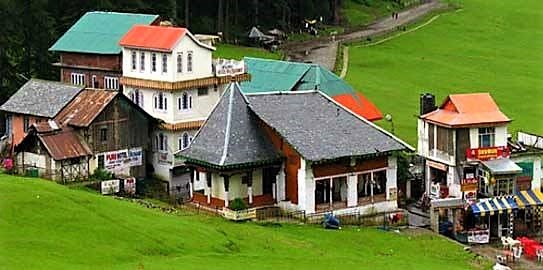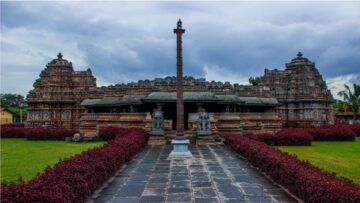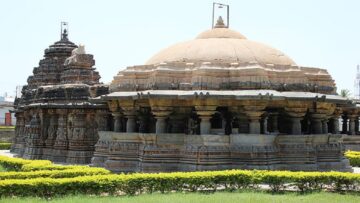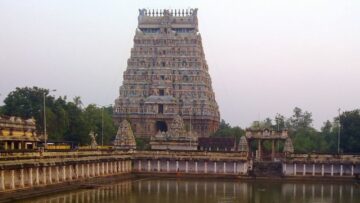The Wonder that is Sringeri
Shri Sringeri Sharada Peetham, located in the foothills of the Western Ghats in the Chikamagaluru district of Karnataka, seems to be straight out of a fairy tale. It is like a portal to another world; a world of flowing rivers, great temples, running deer, roaming elephants, students in white studying Vedic disciplines, teachers taking classes under the shade of a grove, right beside the sinuous watercourse.
One of the greatest seats of learning in Bharat, Dakshinamnaya Sri Sringeri Sharada Peetham, also takes care of the cultural heritage of Karnataka and other states nearby by appointing priests and caretakers, and giving them livelihood from its own coffers. It runs many schools and other institutes besides housing many children, teaching them Sanskrit and many other classical subjects. Furthermore, the Matha holds the ancient Sharada Jagadamba temple too, with the current structure dating back to 11th century.
The divine experience starts as soon as one approaches the precincts of the great Matha. From many miles around, one notices the abundance of thick forests and pristine ecosystem. As one approaches the majestic temple gopuram, one has to deposit the footwear at the counter outside the temple. Inside the temple you can only go barefoot.
Besides, the Sharada temple is a visually spectacular temple called the Vidyashankara temple, one of the first temples built by the Vijayanagar Empire in 14th century. The Matha had a great role in supporting the Vijayanagar Empire intellectually and spiritually. The fourteenth century temple has all the Vishnu avataras sculpted on the outside of the temple in huge reliefs.
Just beyond the temple, flows the river Tunga in majestic grace. Across the river is the Shri Shankaracharya Niwas. There are groves of various trees all around, including the supari (areca nut) groves. The bridge over the river Tunga is a footover bridge which is a private property of the Matha and one cannot wear footwear here as well. When it rains, the entire environs of the Matha become so ethereal that you no longer remember that you are in this world and in this century.
This continues for miles on end as the Sringeri Sharada Peetham owns vast areas of land around the temple precincts. This has prevented the ugly and unlimited encroachment of modern buildings and also the encroachment of evangelical and Islamic groups which are becoming rampant in that region.
The Sacred Trinity
The place has three integral components: a great temple, a sacred grove, and a water body, which in this case is a flowing river. This is not an exception but a norm. Since in modern times, so many temples exist without a sacred grove of trees, it might seem like an exception. A temple never existed without a sacred grove and a water body. There was always a lake, a pond, a river, a well, or an ocean beach alongside it.
The Hindu Temple never existed without a sacred grove. Just like the sacred pond, the sacred garden and the sacred inner precincts, the sacred grove was also an inseparable part of the temple complex. Sanatana Dharma does not just stop at worshiping Nature and extends its worship to divine beings on higher planes of consciousness, mirroring realities on other planes of existence, but this does not mean that it neglects Nature or goes against it.
In Prophetic Monotheistic religions, Nature was a problem to be surmounted, an enemy of man to be defeated. In Sanatana Dharma, Nature is an aspect of reality, one manifestation of the Divine. There is no conquest of Nature. Nature is appeased at best, and flows in harmony with those who walk the path of Self-Realization.
The Garbha-Griha, where the deity, the Supreme Consciousness resides is always dark, illuminated only by the light of the diyas kindled by the priest and illuminating the aspects of the deity, plunging all else in complete darkness. This is to aid the chitta to become quiet, and to witness, to have darshana of the Divine, the Supreme in unmitigated and unflinching attention. In the Garbha-Griha everything else subsides, only the Supreme Consciousness prevails and when the devotee has darshana of the deity, the two become one with the devotee witnessing his True Self in the Deity.
Outside the Garbha-Griha the world starts stirring up. It comes back to Dvaita. Thus, the Antarala is where the priest appears, officiating the Divine Transaction between the Devotee and the Deity. As we proceed outwards towards the various Mandapams, the world starts appearing in all its complexity. Hence the area surrounding the Hindu Temple always used to be a Sacred Grove, which aided the devotees in creating equilibrium while pursuing various disciplines of study.
Nature in full bloom and glory makes the journey of a devotee easier. It is only in Sanatana Dharma that we see a seamless transition between paying attention to the world and paying attention to the ultimate goal.
This ecosystem is not something which evolved later on in the Hindu tradition. In fact it has always been at the core of the temple building tradition in Bharat. This is evident from the tribal and hilly regions of Bharatvarsha which also blend many Desiya traditions, local gods and goddesses and temple traditions with the Margiya tradition of temple building prevalent all across the country.
The Khajji Nag Temple
Himachal Pradesh is one such place where the most ancient local traditions go beautifully together with Agamic injunctions in the temples that continue to be living institutions. Even in these places, the trinity of a great temple, a sacred grove and a great lake is seen in many places. All along this region, the Naga devatas are worshiped profusely. There is no important region in Himachal which does not have a Naga temple. These temples proliferate everywhere but are particularly found in thick groves and jungles.
Khajjiar in Chamba district is famous for such a Naga temple. Today tourists know it for its picturesque beauty, dense forests and paragliding and other sports. It is known as the ‘Mini Switzerland’ in the tourist annals. Most people visiting Khajjiar seldom know about its spiritual and cultural importance.
Khajjiar is one of the most ancient spiritual centers of Chamba district as well as Himachal Pradesh. At its heart is the Nag Temple of Khajjiar. This temple is built in the Himalayan pent-roof style and not just the roof, but the entire building is made of wood. Wooden beams as old as 800 years are still holding this great temple aloft. The wooden temple has a sloping pent roof covered with slates. The temple was completed in 1200 CE; however the temple site is much older than that. (Handa 58)
No place in the land of Bharatvarsha remains unconsecrated with its sacred legends. The entire hilly landscape of Himachal Pradesh is wedded with the various legends of the Mahabharata and particularly with the stories related to the Pandavas. The Pandavas are ubiquitous in Himachal Pradesh. Almost every important sacred center has at least some legend of the Pandavas associated with it.
The Khajji Nag Temple is also deeply associated with the legend of the Pandavas. It is said that the Pandavas hid here while being on Agyaatvaasa – the year when they were in hiding. In order to hide well, they became the gatekeepers of this temple and hence even today you can see the carved wooden icons of the five Pandavas at the doors and pillars of the Khajji Nag Temple.
What is most breathtaking is that the temple exists alongside a great natural spot – the Khajjiar Lake. Right in front of the temple is a great depression with a flat disc around – something rare in the mountain ranges. This lake is considered quite ancient and very sacred. The myth of the Nag temple is conjoined with the lake and the building of the temple is attributed to the discovery of the sacred lake and the residing of the Naga Devata inside the lake. All around the lake there are deodar forests on the hills with the snow-laden mountains always lurking in the background with its perpetually snow-covered peaks.
How Hindu Culture Protected Nature
Three aspects come together here: A Great Temple, a Sacred Lake and a Sacred Grove – and these three are connected with legends and great myths. It is a great way of acknowledging that the surrounding ecosystem will be protected and the natural order will be conserved. The temple houses the same deity which hides in the lake. The temple, a manmade building, a cultural artifact, is nothing but a continuation of its natural ancestor. A dharmic culture is a gatekeeper of natural order among many other things.
Hindu temples never existed without sacred groves of trees around them and never without the sacred pond. A temple could never do without a sacred pond or water body which would not only take care of the needs of the deity but also of the community living around as well. And the sacred grove would make it a perfect place for meditation and self-discovery. The act of darshana of course took place in the garbha-griha, but the surroundings were intricately aligned to the ultimate goal of darshana.
In this way, the Hindu temple as an institution protected sacred groves all across our country. In fact in many places it is now only the temples which are protecting sacred groves on their private property. As soon as their boundary ends, one can see the ecological destruction. Inside the boundaries, the ecosystem remains intact. The ecosystem of the Hindu temple is not just culturally connected with humans but also encompasses Nature within its ambit. It is both a natural and a cultural ecosystem, literally speaking.
Thousands of these sacred groves still survive, and most of them are around a Hindu temple. (Malhotra vii) The temple may be made of stones, wood or even an open air temple with just some icons placed in the open or under a tree, but all of these groves are considered to be extremely sacred and divine and are worshipped as deities or dwelling places of deities. In many places these sacred groves are simply called ‘Devavana’, or a ‘Grove of Deities’. Every village in Bharat used to have one.
These sacred groves around temples were present all over the Bharatvarsha. In Kashmir they are called dev bani, in Uttarakhand dev bhoomi or bugyal, in Bihar as sarnas, in Bengal as hari than, sabitri than etc., in Manipur as umanglai, in Mizoram as ngawpui, in Meghalaya as law lyngdoh, in Rajasthan as vani, in Madhya Pradesh as deogudi, in Chhattisgarh as matagudi, devgudi etc., in Maharashtra and Karnataka as devrayi, in Goa as devran, in Andhra and Telangana as pavitra vana, in Odisha as thakurnam or jahera, in Karnataka as devarkadu/devarkan, in Kerala as kaavu, in Tamil Nadu as kovil thoppu or kovil kaadu. (Krishna 41-50)
This is hardly an exhaustive list of the various names. The tradition is prevalent all across Bharatvarsha and almost always around the Hindu temple.
The Destruction of the Sacred Groves
These sacred groves started disappearing as soon as the cultural ecosystem embedded in dharma necessary to sustain it became outlawed by the Indian State. In fact the destruction of these sacred kshetras had started much earlier. First there were the Islamic invaders and then came the British with various laws freezing temple lands. And the most damage was done post-independence with the Tenants Act which made the temple dependents living on land all around the temple as its legal owners.
The complex web of social relations which incorporated all sections of the society and yet kept the divine goal in sight was destroyed with this act. The sacred groves either became government property directly or were declared as deeds in the name of the people occupying the land. With its roots in Nature and society cut brutally by anti-dharmic laws, the Beautiful Tree of the Temple Ecosystem withered.
With modern and secular sense of life increasingly redefining our ways of living in the 21st century, our dharmic circuits are slowly disappearing – as the village lakes are becoming a dumping ground of waste in many villages in the country so are the Devavana gradually disappearing with the wood being cut for monetary benefit and buildings constructed in their place. But why is this change taking place? Is there something inherently anti-ecological in the modern and secular way of living?
The answer to this would be yes. There is something inherently anti-ecological in the modern/secular way of living and this is a legacy of Judeo-Christian worldview which dictated the Enlightenment process resulting in the modern secular institutions including democracy that we currently are adopting on a global scale.
According to the Judeo-Christian worldview, Culture is the tool of man to mould Nature for his own needs. This is a patently Prophetic Monotheistic interpretation of culture, where man is given the dominion of Earth and where he becomes the master of Nature and all other living beings. There is eternal struggle between man and Nature. Culture is actually a tool to help man win this battle and make a conquest of Nature. In this understanding of Culture, it is always pitted against Nature.
Nature-Culture Continuum vs. Nature-Culture Conflict
This is not how culture is understood in a dharmic society like Bharatvarsha. The word for culture is ‘samskriti’ संस्कृति, while the word for Nature is प्रकृति. Samskriti is the refinement and elevation of Prakruti. Culture is an elevation of Nature.
In the Judeo-Christian paradigm, Nature is pitted against Culture in an eternal struggle. In Bharatvarsha, Culture goes in harmony with Nature and even improves on it, not by destroying it, but by observing its physical rules while spiritually transcending it. Dharma, the carrier of Samskriti, overseas the balance of Culture and Nature and keeps them in harmony and not conflict.
This paradigm is seen in various disciplines and dimensions. For example, while the language of the Vedas and the language of the cultural elite in Bharat was Sanskrit, the language of common people was Prakrit. The word Prakrit simply means, ‘that which is natural’ and referred to the common language/s which came naturally to people. Sanskrit was the language of the gods, language of the ultimate knowledge, and language of the high culture, and that is why it was called ‘Sanskrit’, which means ‘that language which has been refined and made perfect.’
In the West, classical languages like Latin or Roman have always been in conflict with the vernacular languages while in Bharat no such struggle has historically been witnessed. Similarly, the vernacular culture is pitted against the national culture in the West, while in Bharat the Margiya/national culture does not oppose but enriches and elevates the Desiya culture. The same is true about the Loka and the Shastra. While the scriptures in the West have declared the folk literature as evil and base, in Bharat, Sanskrit literature has enriched the folk literature and has been enriched by it in return.
Coming back to the topic of Nature-Culture harmony, it is becoming glaringly evident in the past few decades, that the culture of modern West is inherently unsustainable vis-à-vis its relation with Nature. The collapse of the ecosystems and the general degradation of ecology all around is the greatest testimony to that – but this was not always so.
In pre-Christian Europe there too prevailed a Nature-Culture continuum under the pagan traditions and the pagan ethics that prevailed. Pagan mythology and way of life constantly instituted a sense of awe and respect for Nature in its denizens. That there are consequences of disturbing the cosmic order was also clear to them by various myths, stories and rituals. Man was important, but at best, a small player in the cosmic order of things. He was not the proprietor of either the Earth or the Universe.
With the wholesale adoption of the Judeo-Christian culture in Europe, this sense evaporated almost overnight. The Nature-Culture continuum which existed naturally in Europe during the pre-Christian pagan era was broken. The Continuum was replaced with the Conflict.
Culture became the enemy of Nature in which Nature was seen just as a hostile force which had to be conquered by divine power and grace. The respect and awe for Nature was replaced by a sense that Nature exists for the use of man and man is the proprietor of everything natural.
While Europe came out of the Dark Ages, going through the Renaissance and the Enlightenment, some Judeo-Christian ideas were carried as it is and became central to the idea of the West. While pagan art and science was revived during the Renaissance and the Enlightenment, mythology and religion were not – and without pagan mythology, the respect for Nature could not be generated. The Nature-Culture continuum could not be revived.
A scientific critique from within the Western civilization, of the Conflict paradigm emerged in the 1950s and 60s when environmental science became mainstream. Silent Spring by Rachel Carson was published in 1968 and for the first time made us aware of the mass extinctions caused by chemicals that human beings are using since the industrial revolution. In 1972, the Club of Rome published The Limits to Growth, making the very obvious point that unlimited growth cannot be sustained on limited resources.
In 1979, scientist James Lovelock came out with his Gaia hypothesis, in Gaia, reviving an old pagan idea that Earth itself is a living system, and that if human beings tinker too much with it, it will simply wipe us out. If this was not tragic enough, in his follow up books Revenge of the Gaia and The Vanishing Face of Gaia, Lovelock now believes that the scale of intervention that human beings have made in Mother Nature, we are actually capable of destroying Earth as a living system and turn it into another dead planet like Mars. Many other authors like Tim Flannery in The Weather Makers and Elizabeth Kolbert in The Sixth Extinction warned us how deeply modern civilization is destroying the delicate balance of Nature.
Meanwhile with the evolution of genetics and modern biology, the need for a Nature-Culture continuum was emerging strongly. Edward O. Wilson who actually coined and popularized the phrase ‘Nature-Culture continuum’ proved through his work in epigenetics that Culture is not just human ‘invention’, but actually a continuum of the natural order that prevails on its own in the world. In human life, it is instituted with human laws and ethics and enforced with human institutions. However, the urge to create such a culture is encoded within us in heritable phenotypes. (Wilson 2)
Culture as against the prevailing assumption of humanities in the West, is not ‘arbitrary’ and nor a ‘human invention’. It is a fundamental urge and fundamentally necessary to maintain order. Any study of biology according to this view is incomplete if it does not take in context human society. Edward Wilson thus coined a new term and discipline called ‘socio-biology’ which has the Nature-Culture continuum at its heart.
That the current economic, social and political paradigm of the West is not conducive to Nature-Culture continuum is very well clear with the environmental studies. That it is absolutely crucial to reinstate Nature-Culture paradigm was made clear by socio-biology. The dharmic idea of संस्कृति and प्रकृति is much closer to the ideas that are emerging in some scientific disciplines like socio-biology and various ecological disciplines.
The internal ethos of modern global culture is not sustainable either. While modern societies have become materially very prosperous, most other institutions which uphold culture like family, religion and nation are either destroyed or on their way to destruction. In this paradigm of Nature-Culture Conflict, progress is the sole criterion of human happiness and development with no thought about inner human development.
Loren Eiseley, one of the greatest scientists and philosophers to come out of the West in the last century, also claimed that while Nature was the First Order, Culture was the Second Order, and what ‘modern culture’ has done is to break both the orders, hence the chaos and the destruction all around. He also thought that modern global culture has no provision of ‘inner human development.’
“The western scientific achievement, great though it is, has not concerned itself enough with the creation of better human beings, nor with self-discipline. It has concentrated instead upon things, and assumed that the good life would follow. Therefore it hungers for infinity. Outward in that infinity lies the Garden the sixteenth-century voyagers did not find. We no longer call it the Garden. We are sophisticated men. We call it, vaguely, “progress,” because that word in itself implies the endless movement of pursuit. We have abandoned the past without realizing that without the past the pursued future has no meaning, that it leads, as Morris has anticipated, to the world of artless, dehumanized man.” (Eiseley 130)
The Bhartiya idea of culture not only takes care of creating better human beings but also takes care of Nature and sees culture as not in a conflict, but in a continuum of Nature. The dharmic way of culture is not destructive of Nature. The dharmic way of culture actually protects Nature. This becomes evident in the Hindu temple, the epicenter of all dharmic institutions in Bharatvarsha. The Hindu temple is a protector of Hindu culture as well as Nature.
At Khajjiar Nag temple, it all comes together: the great temple, the sacred grove and the sacred lake. Sadly, even here, the temple is now completely surrounded by ugly hotels and restaurants and you can no longer get a clear shot of it from the front and hardly from the back. The lake used to fill the entire pan earlier but now is just a sorry remnant of its former glory. Let us hope that progress and development do not ruin this great sacred grove. Let us hope that the Indic idea of Culture with its Continuum Paradigm with nature becomes primary. Let us hope and work for a day when all Hindu temples exist in this trinity – the Temple, the Lake and the Sacred Grove.
Notes and References
- Eiseley, Loren. The Firmament of Time. Bison Books, 1999.
- Handa, O. C. Ancient Monuments of Himachal Pradesh. Museum of Kangra Art Publications. 2010.
- Krishna, Nanditha. Hinduism and Nature. Penguin. 2017.
- Malhotra, Kailash C, Yogesh Gokhale, Sudipto Chatterjee, Sanjiv Srivastava. Sacred Groves in India. Aryan Books International. 2007.
- Wilson, Edward O. Sociobiology: The New Synthesis. Harvard University Press. 2000.
Explore Dharmic Circuits
Image Credit: themanali
Disclaimer: The opinions expressed in this article belong to the author. Indic Today is neither responsible nor liable for the accuracy, completeness, suitability, or validity of any information in the article.










